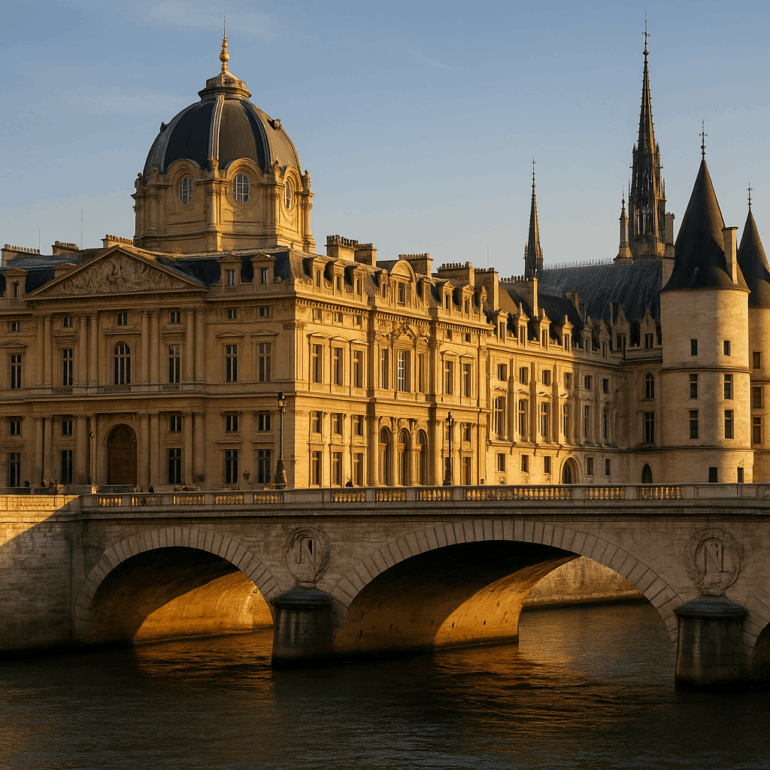Introduction to the Palais de Justice of Paris
The Palais de Justice of Paris is far more than just a building — it is a silent witness to the triumphs and upheavals of French history. Located in the very heart of the Île de la Cité, this imposing structure draws attention with its majesty and architectural elegance. Many pass by without ever realizing the secrets its centuries-old walls hold. I invite you to discover the Palais de Justice of Paris and explore its essential role in France’s legal and cultural landscape.
As soon as you step through the doors of this monument, you feel an atmosphere filled with solemnity and respect for law and justice. Though modern in its operations, the Palais de Justice bears the indelible imprint of events that have shaped the nation. Whether you’re a history enthusiast, an architecture lover, or simply curious, a visit to this iconic site promises a rich and meaningful experience.
Beyond its primary function as the seat of courts and tribunals, the Palais de Justice is a symbol of French judicial authority. It embodies the continuity of justice through the centuries, while adapting to the needs of the present day. In this article, let’s dive together into the depths of its history, architecture, and the artistic treasures it holds.
History of the Palais de Justice of Paris
The history of the Palais de Justice of Paris dates back to medieval times, when King Philip IV (Philippe le Bel) decided to centralize the judicial institutions of his kingdom. Since then, the palace has seen generations of judges, lawyers, and litigants pass through its halls. Over the centuries, it has witnessed some of the most famous trials in French history, including those of Marie-Antoinette and Louis XVI. These events have left a lasting mark and helped shape the country’s legal identity.
In the 19th century, the Palais underwent significant renovations under Napoleon III. Architect Joseph-Louis Duc was commissioned to modernize the structure while preserving its historical essence. These renovations expanded the complex and improved its infrastructure, making it one of the largest courthouses in Europe. In the years that followed, new wings and modern courtrooms were added, while the building’s historic charm was carefully preserved.
Today, the Palais de Justice of Paris remains a central institution in the French judicial system. It houses the Court of Cassation, the highest court in the judicial order, along with other major legal bodies. Despite its modernization, the palace stands as a symbol of stability and continuity in an ever-changing world.
Main Halls and Their Significance
The Palais de Justice of Paris houses several iconic rooms, each with its own meaning and importance within the judicial system. Among them, the Salle des Pas Perdus (Hall of Lost Footsteps) is undoubtedly the most famous. This vast space—where lawyers, magistrates, and litigants cross paths—is the beating heart of the palace. Its evocative name reflects its purpose as a place of waiting, hope, and sometimes, confusion.
Another notable room is the Salle des Criées, where judicial auctions are held. Richly decorated, this room is the setting for significant transactions and decisions that can change lives. Its unique atmosphere—both hushed and solemn—makes it a fascinating place to explore for anyone interested in the inner workings of justice.
Lastly, the Chambre Dorée (Golden Chamber), seat of the Court of Cassation, is a true architectural gem. Its gilded walls and painted ceilings make it a place of prestige and tradition. This is where the most complex legal cases are decided, in full respect of the law and principles of justice. Each room within the palace tells a story and plays a vital role in the functioning of the judicial institution.
Remarkable Works of Art in the Palais
The Palais de Justice of Paris is not only a center of law—it is also a veritable art museum. The artworks that adorn its halls and rooms reflect the rich history and culture of France. Among the most remarkable are paintings, sculptures, and stained-glass windows that enhance the beauty of the palace and enrich the visitor’s experience.
The mural frescoes, created by renowned artists, depict scenes from the judicial history of France. They illustrate key moments such as famous trials and major legislative reforms. These works provide a fascinating insight into the evolution of law and justice throughout the ages. The sculptures, on the other hand, represent allegorical figures of justice—symbolizing wisdom, truth, and fairness.
The stained-glass windows, filtering natural light, add a spiritual and poetic dimension to the palace. Their glow changes throughout the day, creating patterns of light that highlight the building’s architecture. These carefully preserved and restored artworks reflect the care given to beauty and harmony within the Palais de Justice.
Guided Tours and Access to the Palais de Justice
For those wishing to explore the Palais de Justice of Paris in greater depth, guided tours are available year-round. These visits offer the opportunity to explore the palace’s various rooms, learn more about its history and architecture, and discover the artworks it houses. Passionate and knowledgeable guides share the secrets and anecdotes that make this monument so rich in meaning.
Access to the Palais de Justice is subject to certain restrictions to ensure security and the smooth operation of judicial activities. Visitors are advised to check access conditions in advance and to book their place to avoid disappointment. Tours are generally organized in small groups to provide a more intimate and personalized experience.
Don’t miss the chance to visit this iconic site during your next stay in Paris. Whether you’re a resident of the capital or a visiting tourist, the Palais de Justice of Paris is a must-see for anyone interested in history, architecture, or the legal world. You’ll be amazed at the richness waiting behind its centuries-old walls.
Events and Exhibitions at the Palais de Justice
The Palais de Justice of Paris is not only a workplace for legal professionals—it is also a cultural space that regularly hosts events and exhibitions. These gatherings aim to shed light on lesser-known aspects of justice and encourage dialogue between the public and members of the legal world.
Temporary exhibitions, often organized in partnership with cultural institutions, explore a variety of themes related to justice, history, or art. They offer a unique opportunity to engage with complex subjects in an accessible and thought-provoking way. Conferences and debates, meanwhile, provide a deeper look into current legal and societal issues.
Taking part in these events is a great way to experience the Palais de Justice from a different perspective and deepen your understanding of the contemporary challenges of justice. Whether you’re passionate about law, an art lover, or simply curious, you’re sure to find an event that will spark your interest and stimulate reflection.
Legal and Symbolic Importance of the Palais
Beyond its practical function, the Palais de Justice of Paris holds considerable symbolic significance. It represents judicial authority and the rule of law within French society. As the seat of the Court of Cassation, it plays a central role in the interpretation and application of laws, thereby ensuring the protection of fundamental rights and freedoms.
The palace is also a symbol of continuity and stability in a changing world. It stands as a testament to the resilience of the French judicial system in the face of historical challenges and upheavals. Its enduring presence reminds us that, despite political and social changes, justice remains a cornerstone of democracy.
Visiting the Palais de Justice is a powerful reminder of the importance of law in our daily lives and the complexity of the mechanisms behind it. It invites reflection on our relationship with justice and our responsibilities as citizens. Through its history and architecture, the Palais de Justice of Paris urges us to uphold the values of justice and fairness.
How to Get There: Practical Tips
Getting to the Palais de Justice of Paris is relatively easy thanks to its central location on the Île de la Cité. There are several convenient options for reaching this iconic site. You can take the metro—line 4 drops you off at Cité station, just a short walk from the palace. For those who prefer the bus, multiple lines also serve the area.
If you’re arriving by car, be aware that parking in central Paris can be challenging. It’s best to use nearby public parking facilities or opt for public transport. For those who enjoy walking, the palace is accessible on foot from many of the capital’s landmarks, such as Notre-Dame Cathedral or the Marais district.
Finally, be sure to check the opening hours and access conditions before your visit to make the most of your experience. Set aside some time to explore the surrounding area and discover other treasures of the Île de la Cité. A visit to the Palais de Justice is the perfect opportunity to immerse yourself in the rich history and culture of Paris.
Conclusion: The Legacy of the Palais de Justice of Paris
The Palais de Justice of Paris is far more than just a building—it is a living legacy that continues to shape our society. Through its history, architecture, and artistic treasures, it invites us to reflect on the role of justice in our lives and the importance of preserving the values upon which it stands. Whether you are a legal professional, a historian, or simply curious, discovering the Palais de Justice is a rewarding and inspiring experience.
By visiting this iconic site, we delve into the depths of France’s history and gain a deeper understanding of the complexities behind our judicial system. The Palais de Justice reminds us that the pursuit of justice is a continuous endeavor—one that requires dedication and determination. It is a call to defend the rights and freedoms we hold dear and to strive for a more equitable world.
I encourage you to discover the Palais de Justice of Paris for yourself and to share your experience with others. Whether you are inspired by its history, amazed by its architecture, or moved by its symbolism, you will leave with a new perspective on the importance of justice in our society. Don’t hesitate to plan your visit and let yourself be captivated by this eternal monument.





